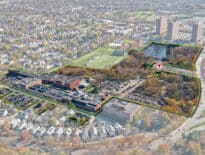Jay Connolly
President, Connolly Brothers Inc.
Age: 36
Industry experience: 13 years
Connolly Brothers originally made a name for itself on the North Shore by building grand seaside estates during the Gilded Age. Today, the Beverly-based construction company specializes in a wide range of commercial and institutional projects, including a newly completed headquarters for manufacturer Harmonic Drive in Beverly’s Dunham Ridge Business Park. After joining the company in 2007 as a project manager, Jay Connolly was named president of the 140-year-old firm early this year. He succeeds his father, Stephen J. Connolly IV, who is moving to an advisory role.
Q: What made 2020 the right time for the leadership change?
A: My dad is the type of person that’s probably not ever going to fully retire, but at the same time, he’s pushed and given me the opportunity to do things without him micromanaging in the background. It was a good time for him, the business is going well and we’re busy. He’s still very much involved, but it was good timing with the business ad where he is in life. He’s 73 and we all felt it was time to make the changes.
Q: How has the business plan evolved over five generations?
A: The company was started by my great-great-grandfather and his three brothers, doing road and utility work, and then they picked up some high-end residential work in the Beverly Farms area. There were a lot of mansions along the coast here, and they developed a niche doing high-end residential work, which turned into doing swimming pools and ornate landscaping and tennis courts and things like that. In the early 1900s, they were doing projects up into the Canadian maritime provinces and as far as Virginia, which always blows my mind. We do projects now within 50 miles of Beverly and managing work outside of that is complicated even with the technology we have at our fingertips.
Each generation has been forward-thinking and had the ability to adapt with the industry, and demand for projects has changed. My dad started in the early 1970s and the company was still doing a huge amount of single-family high-end residential work and we had 180 people here. We were still self-performing a lot of the trade work on projects, and that was the old style of construction companies. As time went on, my dad purposely started phasing out the residential work. Also the industry was changing, and people started hiring subcontractors. We used to have masons and carpenters and were making our own millwork in-house, and [were] becoming less competitive. The industry model changed in the 1980s and the 1990s. So, we phased out the residential work and made the company what it is today: a general contractor and construction manager.
Q: What have you learned about construction timetables and how they’re affected by social distancing on job sites?
A: It’s interesting. I have this theory that our industry, and maybe a lot of industries, are in shock mode and haven’t figured out what the real effects of this are. When the shutdowns started happening, we were lucky all the work we have at the time was deemed essential. Some of this has to do with the size of projects we work on: the $250,000 to $25 million range. Even on the larger projects, we don’t have 200 people reporting every day like a downtown Boston project would.
We also initially didn’t see much of a problem with the supply chain, but we’re starting to see it now. Companies, wherever they may be in the world, burned through inventory and now some of the supplies are not available. It may be a temporary thing, but there’s definitely a major disruption to the supply chain in the different trades.
We’re also seeing difficulty in the permitting process. All the cities and towns have remote workforces now, so in the old days of five months ago, if you were applying for a building permit, oftentimes you picked up the permit in person and handed the check to the person in the building department. Now everything’s remote. You mail the check in, and who knows who’s collecting the check at the building. We’re had three projects, all in different municipalities, where checks have been lost. So that’s just an example of the ripple effect in things being upended.
Q: What dollar range project is most competitive now among the range that you pursue?
A: We don’t typically tackle something over $25 million, but you see a lot in the $2 million to $10 million range. We just lost two jobs that were just shy of $10 million in the last month. We were one of three bidders on one and four on the other. We were pretty damn aggressive on those jobs, and we didn’t get them. So, what does that tell me? Someone else was more aggressive, or they forgot something. People are really digging deep to get work in their backlog right now. The strategy could be to just go super-aggressive and hope you can make it up through the project and find the holes in the plans and justify change orders. Some people do that anyways. I don’t know what it is, but it’s definitely getting competitive and people are nervous.
Q: Meds and eds have been recession-resistant in past economic downturns but higher education, in particularly, is reeling from COVID-19 effects. What building sectors do you expect could pick up the slack?
A: Multifamily is going to keep chugging along, because the demand is still not satisfied. Manufacturing and industrial is going to stay hot, perhaps more so than it has been. I’m confident there’s going to be a stronger push for U.S. manufacturing, and manufacturing and industrial flex space is going to step up. That suburban construction market that we work in is really going to stay active.
Q: Are commercial landlords starting to convert retail and restaurant space into other uses?
A: I haven’t seen it myself, but they’ve got to be [considering it]. I also think there’s not necessarily enough time that’s passed for some of these retail operations. They’re still in shock mode and haven’t been able to figure out if they’re going to weather this or not. They have the Band-Aid but they’re not sure if they need the whole tourniquet yet. But the landlords, if they own a lot of retail space, have to be thinking about the long-term picture.
Connolly’s Children’s Five Favorite Books
- Little Blue Truck
- Iggy Peck Architect
- Goodnight Construction Site
- The Adventures of JB Rabbit
- Green Eggs & Ham




 |
| 


